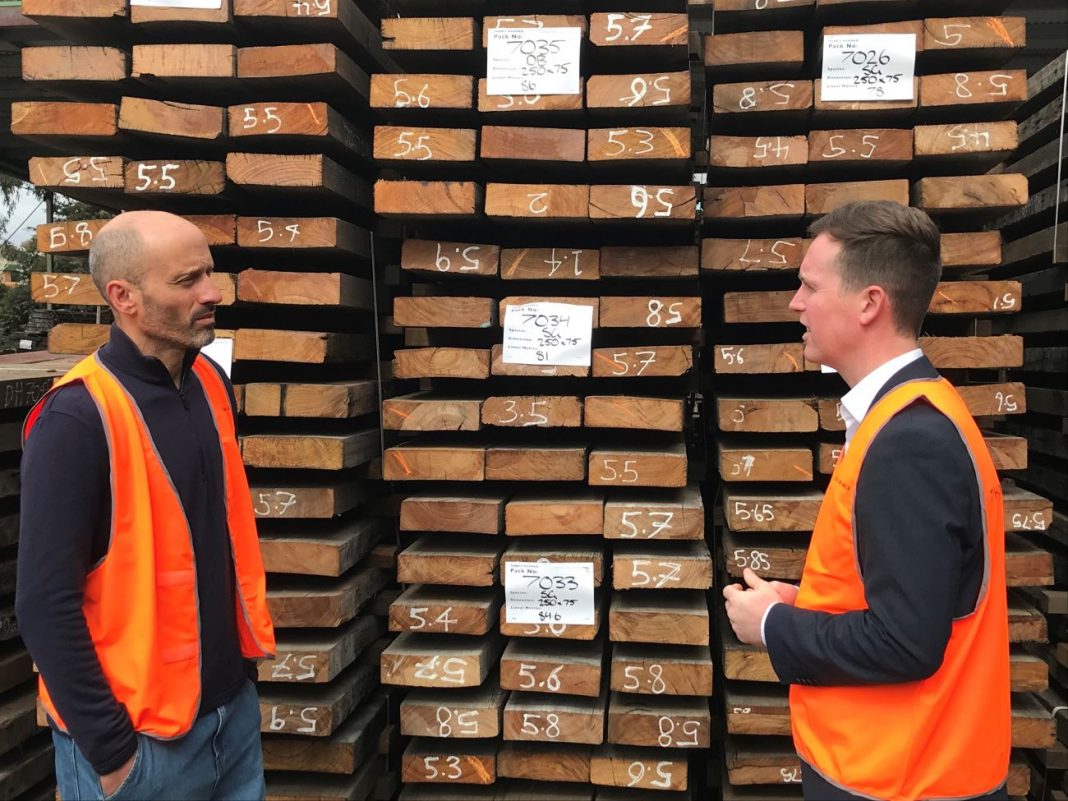Nearly 30 years ago, Thor Diesendorf, horrified by how much old-growth timber was being wasted from house demolitions, set up a company to turn that timber into furniture and architectural products. Today, Thor’s Hammer is a thriving business, recycling more than 1,500 tonnes of timber every year.
“A really great example of the circular economy in action in the ACT,” Chris Steel, ACT Minister for Transport and City Services, said.
And a fitting place to launch the government’s final Circular Economy Strategy and Action Plan 2023–2030.
Nearly one year in the making, the document sets out, Mr Steel explained, “how we build a circular city – one where we value resources and want to make sure that those resources are used time and time again at their highest value, but also making sure that we design out waste from the very beginning so that it doesn’t end up in landfill, and the resources that we do have to use are used to their highest value.”
The circular economy, the document states, is “a cyclical, regenerative system that minimises resource inputs, waste, emissions and energy.” It aims to stop producing waste in the first place, and achieve sustainable consumption and production, avoiding negative impacts on the environment.
“The circular economy is going to be really important for the ACT for reducing pollution, reducing waste, reducing energy use, and also potentially solving material shortages,” Mr Diesendorf said.
The Strategy focuses on six main areas, including making sure food and garden organics are composted and used in agriculture and gardens; sustainable building; and emerging and problematic waste streams, like batteries.
Large numbers of these are coming into the waste stream, Mr Steel said. “This is a problematic material that can create safety issues for workers when they are disposed of in the wrong way.” As the December fire at Hume’s Materials Recovery Facility, sparked by lithium batteries, showed. But valuable materials can be recovered from batteries, so they can be safely disposed of.
Nationally, the ACT Government will advocate that the Commonwealth establish product stewardship schemes for larger batteries; if the Commonwealth fails to act, the ACT may establish its own product stewardship scheme legislation.
“That’s not our preference,” Mr Steel said. “We prefer national action to address products in a national market. But we are prepared to step in if necessary.”
The ACT Government will provide complementary regulation, banning materials from going into landfill where they are already covered by a product stewardship scheme.
The government intends to set up innovation hubs for recycling and reuse of materials, providing space for the circular economy to grow in Canberra, Mr Steel said. “We could continue to send all of our materials for processing and recycling interstate, or we could do more here and create local jobs, local businesses.”
In this week’s Legislative Assembly session, the government will introduce a legislative framework for the Strategy. This includes mandating food reduction plans for ACT food businesses, and making sure that businesses separate the different streams of waste they have. This will, Mr Steel said, “incentivise businesses to do the right thing, set a level playing field for businesses who are doing the right thing, and encourage new sustainable buildings to be built through the planning system”.
On Tuesday, the government will release a tender for the new Materials Recovery Facility, replacing the one at Hume, and ask suppliers to develop interim solutions to manage material from yellow-topped recycling bins.
The government also intends to build new recycling facility for food and garden organic waste, which will open around 2026. This was announced last year, but the Materials Recovery Facility takes priority. In the interim, Mr Steel said, the FOGO pilot, which began running in Belconnen suburbs in 2021, will continue.
The ACT has already introduced bans on single-use plastics, a container deposit scheme, and uses recycled content in its infrastructure projects, Mr Steel said.
The ACT has “many fantastic” recycling and circular economy businesses, he said.
“More jobs are created when we recycle products, when we reuse products – it’s estimated that for every 10,000 tons of material produced, 9.2 jobs are created when we recycle that material, compared to just 2.8 jobs when we send it to landfill.”
Mr Diesendorf would agree. Since Thor’s Hammer began in 1994, he said, the business has added one employee every year, employing more than 30 people making building products like flooring, decking, joinery and furniture. In the last four years, the business has doubled in size, moved to a new facility, and put in new equipment and machinery.
Thor’s Hammer supplies recycled timber products to 360 Building Solutions, 35 Degrees, Green House Architects, Light House Architecture & Science, and Classic Constructions. Likewise, Mr Diesendorf remarked, Capital Brewing reduced their water and energy use, and have gone carbon neutral, while GoTerra and Capital Scraps turn food waste into protein, fertiliser, and compost.
“Canberrans are also demonstrating leadership in growing the circular economy, with some great initiatives such as repair cafés, Community Toolbox Canberra, Lids for Kids, and thriving second-hand markets,” Mr Steel said.
“I’m looking forward to seeing an ACT circular economy strategy that will give help to all the innovative businesses in the ACT and the community organisations as well,” Mr Diesendorf said, “and also put in place incentives for people and consumers to purchase high-quality products or products that can be easily reusable or recyclable.”
Canberra Daily is keen to hear from you about a story idea in the Canberra and surrounding region. Click here to submit a news tip.



